Radon Transport, Accumulation Patterns, and Mitigation Techniques Applied to Closed Spaces
Abstract
:1. Introduction
2. Materials and Methods
2.1. Construction under Study
2.1.1. Main Wing: Galleries and Adjacent Spaces
2.1.2. Acoustic Wing: Reverberation Chamber and Adjacent Spaces
2.2. Sensors and Data Acquisition Systems
2.2.1. Radon Measuring System
2.2.2. Radon Extraction System
2.2.3. Differential Pressure system
3. Experiments
3.1. Tests in Galleries
- Pressurization test: The fan drove fresh air into Gallery A, increasing the indoor pressure.
- Forced ventilation test: The fan extracted the air from Gallery A, forcing the ventilation of the space through the office window.
- Depressurization test: The fan extracted exhaust air from Gallery A, reducing the internal pressure.
- Natural one-sided ventilation: Gallery A was connected to the outside through a flexible duct that allowed for the exchange of naturally driven air with the outside.
- Natural state (reference state): The radon concentrations and pressure levels were measured with the gallery completely closed and sealed. The mitigation systems were disabled. This state is considered to be the reference state for all the experiments.
3.2. Tests in Reverberation Chamber
- Initial data: The radon data were recorded in the office and reverberation chamber using two Radon Eye RD200 detectors. The differential pressure data were recorded with pressure sensor equipment. The reverberation chamber maintained normal work activity.
- Steady test: The evolution of the radon levels in a completely closed space over a long period of time was determined to establish the maximum radon levels reached in the reverberation chamber.
- Reverberation chamber remediation test: Different remediation tests were carried out to determine the healthy levels of radon concentration in the reverberation chamber. (0) The natural state before remedial actions was measured. The levels were recovered between each test to establish the initial radon levels of around 600 Bq/m3. (1) The pressurization test introduced fresh air into the acoustic chamber. (2) A forced ventilation test was carried out and repeated in (4) to evaluate a rare increase in indoor radon levels. (3) The depressurization test extracted the exhaust air from the interior.
4. Results and Discussion
4.1. Main Wing—Results of Facility Galleries and Nearest Living Places: Natural State
4.2. Main Wing—Radon in Facility Galleries and Nearest Living Places: Radon Mitigation Test
4.3. Acoustic Wing—Results of Reverberation Chamber and Office: Natural State
4.4. Results of Acoustic Wing: Radon Mitigation Test at Reverberation Chamber
5. Conclusions
Author Contributions
Funding
Institutional Review Board Statement
Informed Consent Statement
Acknowledgments
Conflicts of Interest
References
- World Health Organization. WHO Handbook on Indoor Radon. A Public Health Perspective; World Health Organization: Geneva, Switzerland, 2009. [Google Scholar]
- Ruano-Ravina, A.; Prini-Guadalupe, L.; Barros-Dios, J.M.; Abal-Arca, J.; Leiro-Fernández, V.; González-Silva, A.I.; Golpe-Gómez, A.; González-Barcala, F.J.; Pena, C.; Montero-Martínez, C.; et al. Exposure to Residential Radon and Lung Cancer in Never-Smokers: The Preliminary Results of the LCRINS Study. Arch. Bronconeumol. 2012, 48, 405–409. [Google Scholar] [CrossRef] [PubMed]
- Nazaroff, W.W.; Moed, B.A.; Sextro, R.G. Soil as a Source of Indoor Radon, Generation, Migration, and Entry. In Radon and Its Decay Products in Indoor Air; Nazaroff, W.W., Nero, A.V., Eds.; John Wiley & Sons: Hoboken, NJ, USA, 1988; pp. 57–112. [Google Scholar]
- Nero, A.V.; Gadgil, A.J.; Nazaroff, W.W.; Reyzen, K.L. Indoor Radon and Decay Products: Concentrations, Causes, and Control Strategies; U.S. Department of Energy, Office of Health and Environmental Research: Washington, DC, USA, 1990; pp. 42–60.
- Vasilyev, A.V.; Zhukovsky, M.V. Determination of Mechanisms and Parameters Which Affect Radon Entry into a Room. J. Environ. Radioact. 2013, 124, 185–190. [Google Scholar] [CrossRef] [PubMed]
- Font Guiteras, L. Radon Generation, Entry and Accumulation Indoors. Ph.D. Thesis, Universitat Autònoma de Barcelona, Barcelona, Spain, 2011; pp. 5–48. [Google Scholar]
- Sabbarese, C.; Ambrosino, F.; D’Onofrio, A. Development of Radon Transport Model in Different Types of Dwellings to Assess Indoor Activity Concentration. J. Environ. Radioact. 2021, 227, 106501. [Google Scholar] [CrossRef] [PubMed]
- Yarmoshenko, I.; Zhukovsky, M.; Onishchenko, A.; Vasilyev, A.; Malinovsky, G. Factors Influencing Temporal Variations of Radon Concentration in High-Rise Buildings. J. Environ. Radioact. 2021, 232, 106575. [Google Scholar] [CrossRef]
- Girault, F.; Perrier, F. Estimating the Importance of Factors Influencing the Radon-222 Flux from Building Walls. Sci. Total Environ. 2012, 433, 247–263. [Google Scholar] [CrossRef]
- Minkin, L.; Shapovalov, A.S. Thermo-Diffusional Radon Waves in Soils. Sci. Total Environ. 2016, 565, 1–7. [Google Scholar] [CrossRef]
- Yang, J.; Busen, H.; Scherb, H.; Hürkamp, K.; Guo, Q.; Tschiersch, J. Modeling of Radon Exhalation from Soil Influenced by Environmental Parameters. Sci. Total Environ. 2019, 656, 1304–1311. [Google Scholar] [CrossRef]
- Blanco-Rodríguez, P.; Fernández-Serantes, L.A.; Otero-Pazos, A.; Calvo-Rolle, J.L.; Javier, F.; Juez, D.C. Radon Mitigation Approach in a Laboratory Measurement Room. Sensors 2017, 17, 1090. [Google Scholar] [CrossRef] [Green Version]
- Vázquez, B.F.; Adán, M.O.; Quindós Poncela, L.S.; Fernandez, C.S.; Merino, I.F. Experimental Study of Effectiveness of Four Radon Mitigation Solutions, Based on Underground Depressurization, Tested in Prototype Housing Built in a High Radon Area in Spain. J. Environ. Radioact. 2011, 102, 378–385. [Google Scholar] [CrossRef]
- Cosma, C.; Papp, B.; Cucoş (Dinu), A.; Sainz, C. Testing Radon Mitigation Techniques in a Pilot House from Băiţa-Ştei Radon Prone Area (Romania). J. Environ. Radioact. 2015, 140, 141–147. [Google Scholar] [CrossRef]
- Ptiček Siročić, A.; Davor Stank, N.; Dogančić, D.; Trojko, T. Short-Term Measurement of Indoor Radon Concentration in Northern Croatia. Appl. Sci. 2020, 10, 2341. [Google Scholar] [CrossRef] [Green Version]
- Whyte, J.; Falcomer, R.; Chen, J. A Comparative Study of Radon Levels in Federal Buildings. Health Phys. 2019, 117, 242–247. [Google Scholar] [CrossRef] [PubMed] [Green Version]
- Ruano-Ravina, A.; Narocki, C.; López-Jacob, M.J.; García, A.; De, M.; Calle, C.; Peón-gonzález, J.; Barros-dios, J.M. Indoor Radon in Spanish Workplaces. A Pilot Study before the Introduction of the European Directive 2013/59/Euratom. Gac. Sanit. 2019, 33, 563–567. [Google Scholar] [CrossRef] [PubMed]
- Muñoz, E.; Frutos, B.; Olaya, M.; Sánchez, J. A Finite Element Model Development for Simulation of the Impact of Slab Thickness, Joints, and Membranes on Indoor Radon Concentration. J. Environ. Radioact. 2017, 177, 280–289. [Google Scholar] [CrossRef] [PubMed]
- Rizo Maestre, C.; Chinchón Yepes, S.; Echarri Iribarren, V. The Radon Gas in Underground Constructions. Railway Tunnel of Alicante (Spain). Int. J. Eng. Technol. 2018, 7, 393–395. [Google Scholar] [CrossRef] [Green Version]
- Kowalczk, A.J.; Froelich, P.N. Cave Air Ventilation and CO2 Outgassing by Radon-222 Modeling: How Fast Do Caves Breathe? Earth Planet. Sci. Lett. 2010, 289, 209–219. [Google Scholar] [CrossRef]
- Sainz, C.; Rábago, D.; Celaya, S.; Fernández, E.; Quindós, J.; Quindós, L.; Fernández, A.; Fuente, I.; Arteche, J.L.; Quindós, L.S. Continuous Monitoring of Radon Gas as a Tool to Understand Air Dynamics in the Cave of Altamira (Cantabria, Spain). Sci. Total Environ. 2018, 624, 416–423. [Google Scholar] [CrossRef]
- Rizo Maestre, C. The Radon Gas in Underground Buildings in Clay Soils. The Plaza Balmis Shelter as a Paradigm. Int. J. Environ. Res. Public Health 2018, 15, 1004. [Google Scholar] [CrossRef] [Green Version]
- Soniya, S.R.; Abraham, S.; Uddin, M.; Jojo, P.J. Investigation of Diffusive Transport of Radon through Bricks. Radiat. Phys. Chem. 2021, 178, 108955. [Google Scholar] [CrossRef]
- Frutos, B.; Martín-Consuegra, F.; Alonso, C.; Perez, G.; Peón, J.; Ruano-Ravina, A.; Barros, J.M.; Santorun, A.M. Inner Wall Filler as a Singular and Significant Source of Indoor Radon Pollution in Heritage Buildings: An Exhalation Method-Based Approach. Build. Environ. 2021, 201, 108005. [Google Scholar] [CrossRef]
- Nastro, V.; Carnì, D.L.; Vitale, A.; Lamonaca, F.; Vasile, M. Passive and Active Methods for Radon Pollution Measurements in Historical Heritage Buildings. Meas. J. Int. Meas. Confed. 2018, 114, 526–533. [Google Scholar] [CrossRef]
- Rizo Maestre, C.; Echarri Iribarren, V. The Importance of Checking Indoor Air Quality in Underground Historic Buildings Intended for Tourist Use. Sustainability 2019, 11, 689. [Google Scholar] [CrossRef] [Green Version]
- Lario, J.; Sánchez-Moral, S.; Cañaveras, J.C.; Cuezva, S.; Soler, V. Radon Continuous Monitoring in Altamira Cave (Northern Spain) to Assess User’s Annual Effective Dose. J. Environ. Radioact. 2005, 80, 161–174. [Google Scholar] [CrossRef] [PubMed]
- Goy Goy, J.L.; Pérez González, A.; Zazo Cardeña, C.; Calvo Sorando, J.P.; Vegas Martínez, R.; San José Lancha, M.A. Mapa Geológico de España E1:50.000 MADRID Segunda Serie—Primera Edición. Hoja 559 19-22 2020. Available online: https://mapas.igme.es/gis/rest/services/Cartografia_Geologica/IGME_MAGNA_50/MapServer (accessed on 1 October 2022).
- Garcia-Talavera San Miguel, M.; Martin-Matarranz, J.L.; Gil de Mingo, R.; García Cadierno, J.P.; Suárez Mahou, E. El Mapa Predictivo de Exposición Al Radón En España; Colección Informes Técnicos 38.2013; Consejo de Seguridad Nacional: Madrid, Spain, 2013; Volume 141, pp. 40–42. [Google Scholar]
- Sicilia, I.; Aparicio, S.; Frutos, B.; Muñoz, E.; González, M.; Anaya, J.J. A Multisensor System for the Characterization of the Field Pressure in Terrain. Accuracy, Response, and Adjustments. Sensors 2019, 19, 3942. [Google Scholar] [CrossRef] [Green Version]
- Rydock, J.P.; Skåret, E. A Case Study of Sub-Slab Depressurization for a Building Located over VOC-Contaminated Ground. Build. Environ. 2002, 37, 1343–1347. [Google Scholar] [CrossRef]
- Singh, K.; Singh, M.; Singh, S.; Sahota, H.S.; Papp, Z. Variation of Radon (222Rn) Progeny Concentrations in Outdoor Air as a Function of Time, Temperature and Relative Humidity. Radiat. Meas. 2005, 39, 213–217. [Google Scholar] [CrossRef]




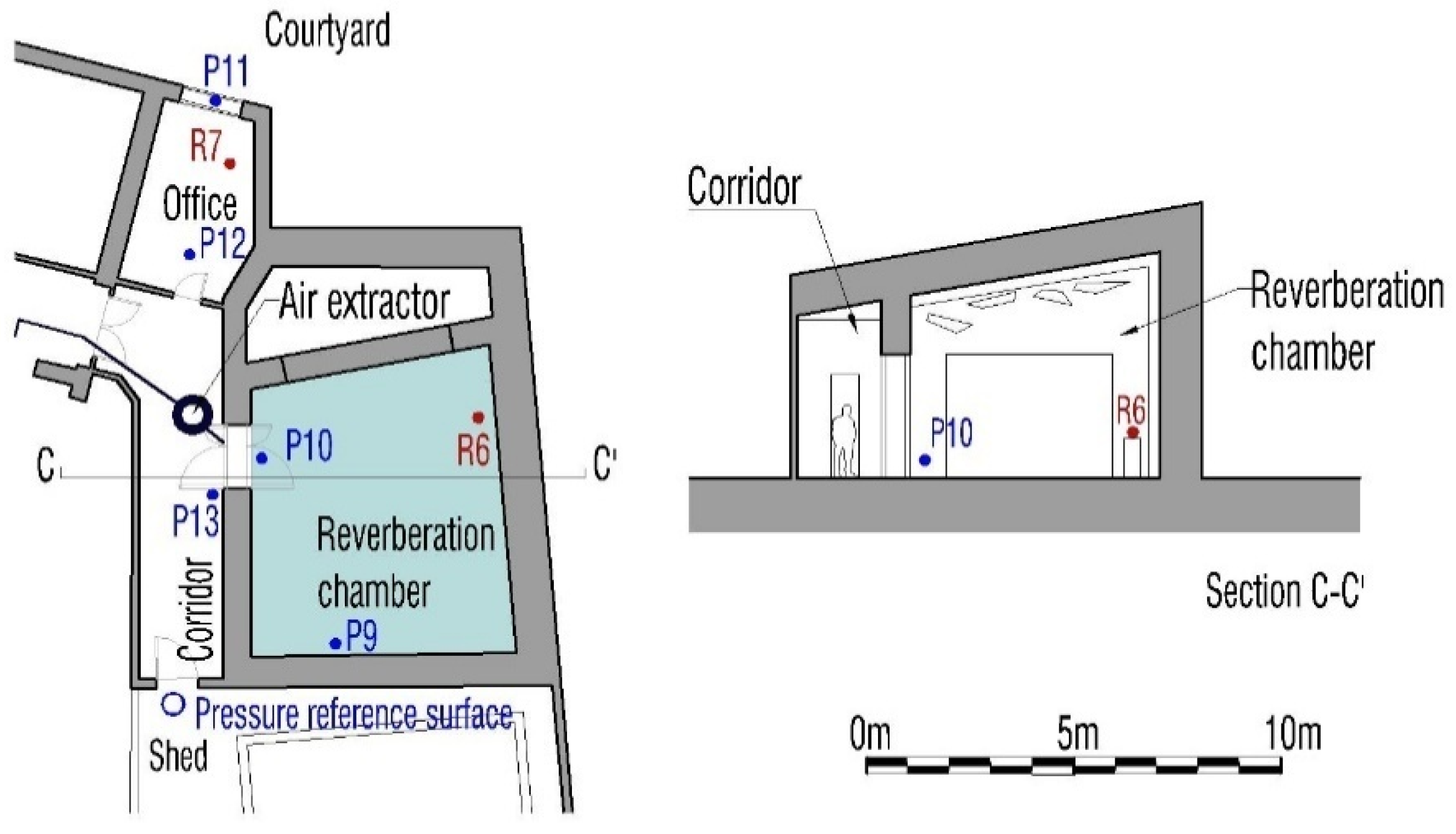
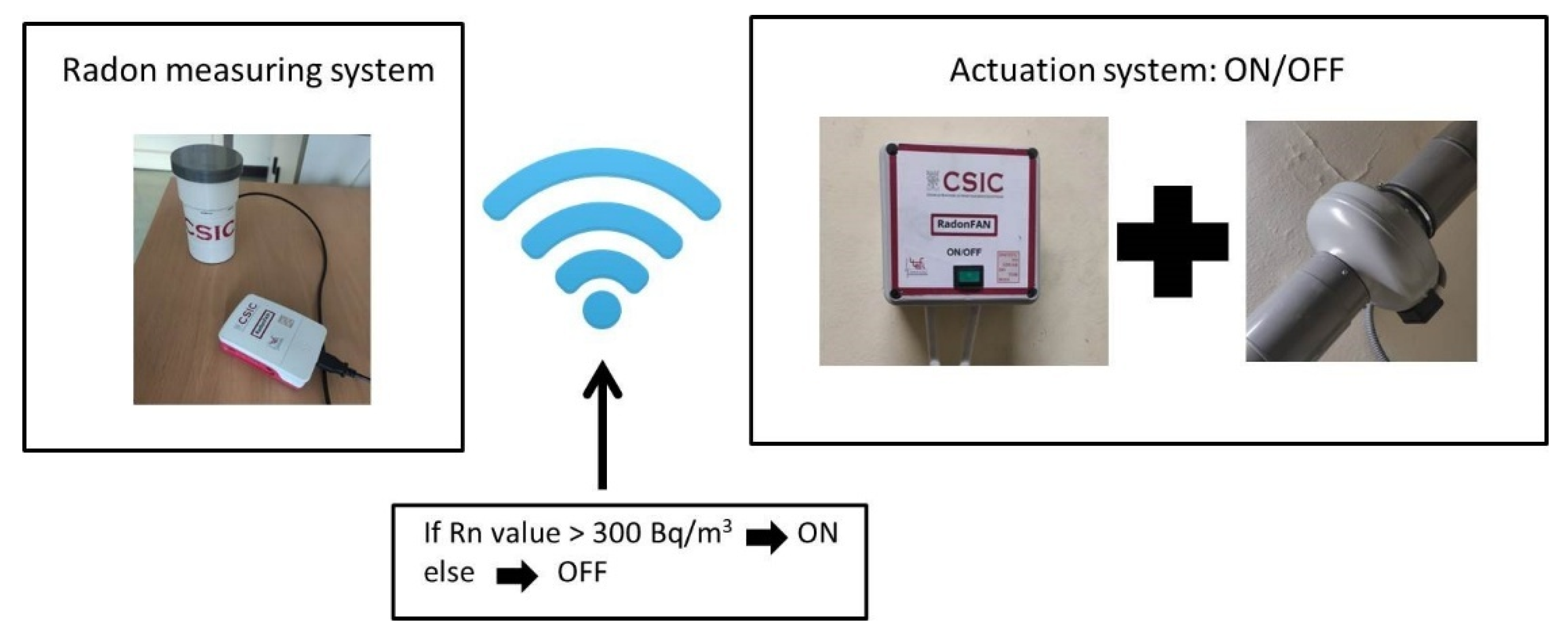

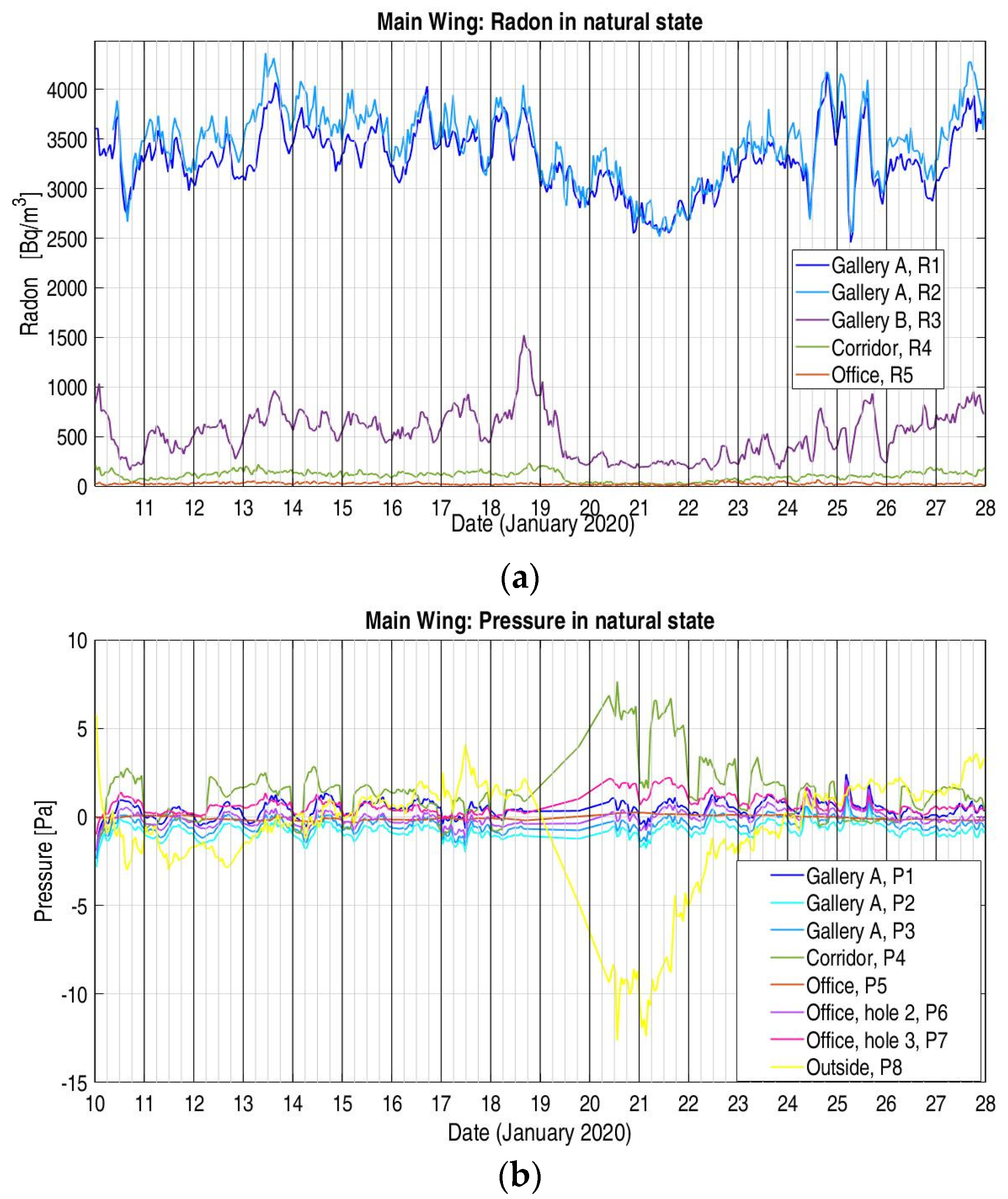

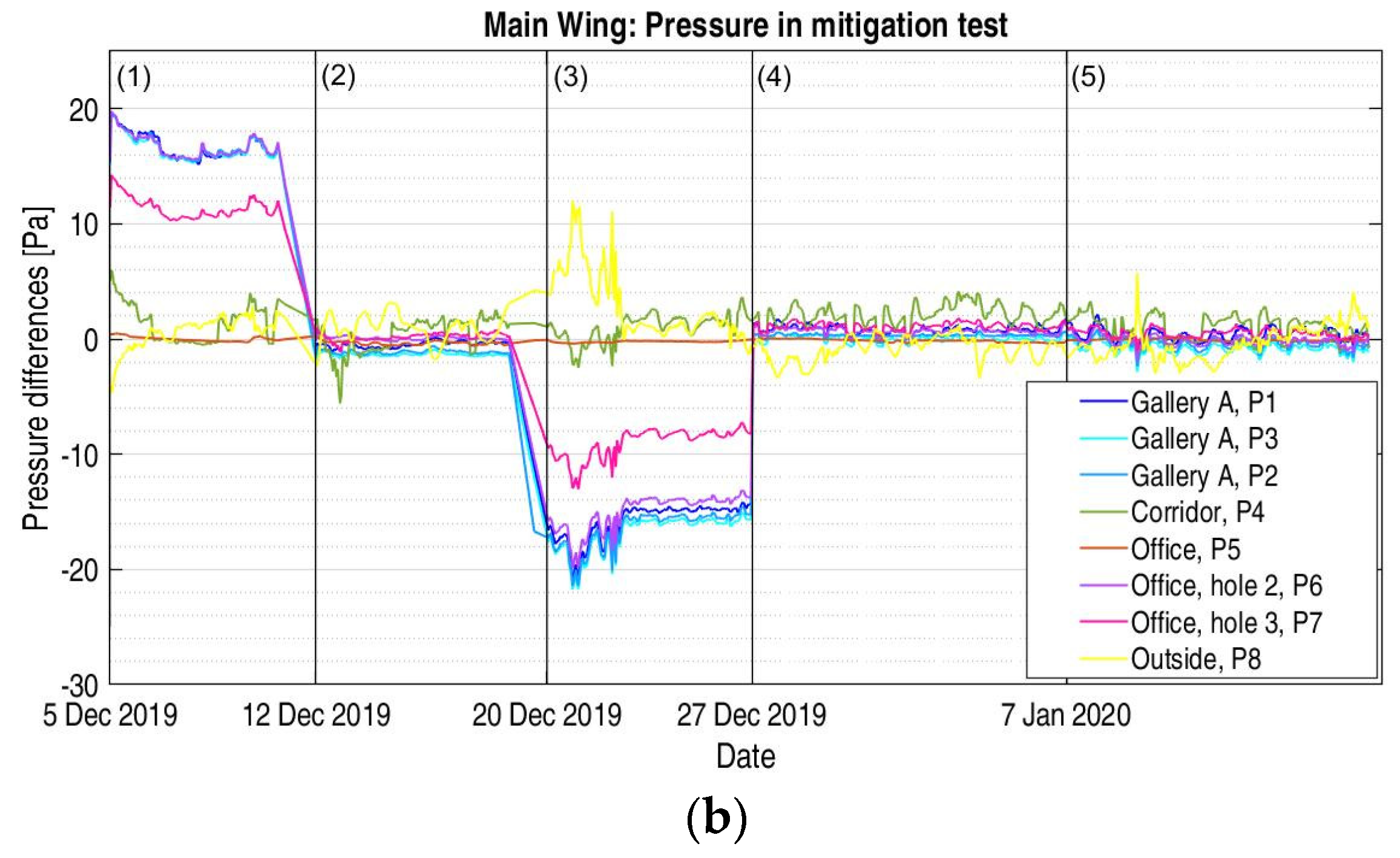



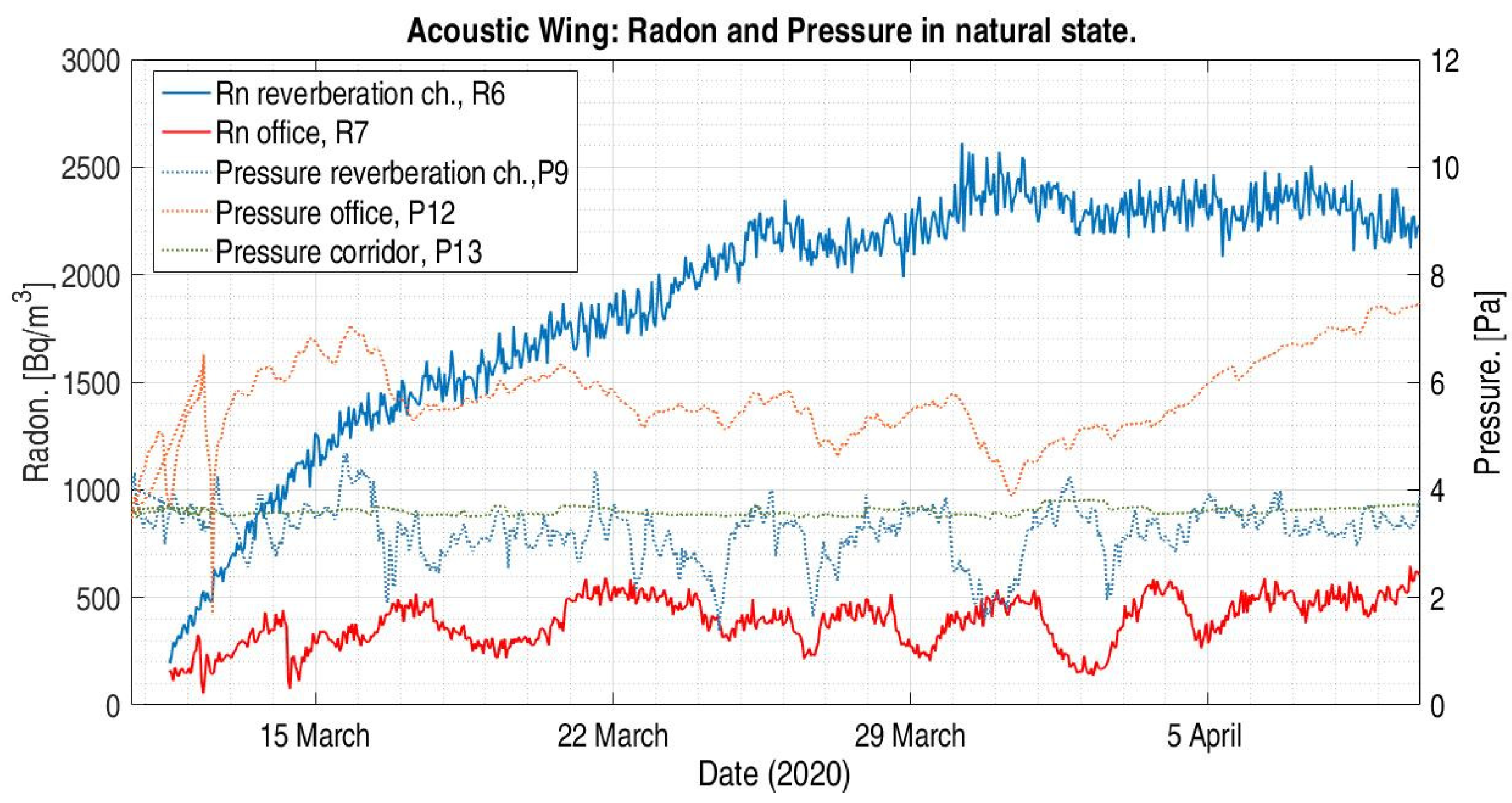

| ? | Volume | Outdoor Contact | Indoor Contact | Level (Courtyard Reference) |
|---|---|---|---|---|
| m3 | m2 | m2 | m | |
| MAIN WING | ||||
| Gallery A | / | 0.8 | −0.42/−1.66 | |
| Gallery B | / | 0.8 | −0.42/−1.66 | |
| Corridor | 361 | contact with ventilated spaces | with several spaces | −3.08 |
| Office | 62 | 2.9 window | 0.87 | |
| ACOUSTIC WING | ||||
| Reverberation chamber | 210 | / | 5.8 | 0 |
| Office—acoustic | 45.6 | 1.95 window | 1.7 | 0 |
| Corridor—acoustic | 77.9 | / | with several spaces | 0 |
| Shed—acoustic | 0 |
| Measure Points | Radon | Pressure | Observations |
|---|---|---|---|
| MAIN WING | |||
| Gallery A, door | Radon + Raspberry (R1) | 1 sensor (P1) | |
| Gallery A, back (Hole 1) | Radon Eye RD200 + (R2) | 2 sensors, at different heights: 1 and 0.5 m from above (P2, P3) | |
| Gallery B, door | Radon Eye RD200 + (R3) | ||
| Corridor | Radon Eye RD200 (R4) | 1 sensor (P4) | |
| Office | Radon Eye RD200 (R5) | 2 sensors (table, P5 + outside, P8) | Referential pressure in floor |
| Office (Hole 2) | 1 sensor (P6) | ||
| Office (Hole 3) | 1 sensor (P7) | ||
| ACOUSTIC WING | |||
| Reverberation chamber | Radon Eye RD200 (R6) | 2 sensors (inner, P9 + door, P10) | |
| Office—acoustic | Radon Eye RD200 (R7) | 2 sensors (window, P11 + floor, P12) | |
| Corridor—acoustic | 1 sensor (P13) | ||
| Shed—acoustic | Referential pressure in floor |
| ? | Gallery A—Door | Gallery A—Back | Gallery B—Door | Corridor | Office | |||||
|---|---|---|---|---|---|---|---|---|---|---|
| Mean | SD | Mean | SD | Mean | SD | Mean | SD | Mean | SD | |
| 1. Pressurization | 35.7 | 32.5 | 61.7 | 15.3 | 617.0 | 241.7 | 62.0 * | 16.5 | 33.9 | 11.8 |
| 2. Forced ventilation | 406.0 | 156.2 | 139.5 | 40.0 | 989.5 | 315.9 | 84.7 * | 25.0 | 11.4 * | 6.3 |
| 3. Depressurization | 1292.6 | 221.1 | 606.3 | 122.8 | 623.5 | 277.6 | 176.0 * | 36.2 | 18.2 | 10.7 |
| 4. Natural ventilation | 802.2 | 217.8 | 1319.8 | 391.3 | 482.1 | 142.5 | 49.3 * | 16.3 | 56.7 | 17.3 |
| 5. Natural state | 3246.2 | 486.3 | 3422.3 | 541.1 | 559.5 | 230.1 | 104.3 | 49.1 | 28.3 | 15.4 |
| ? | Gallery A—Door | Gallery A—Back/Sensor P2 | Gallery A—Back/Sensor P3 | Office, Hole 2 | Office, Hole 3 | Corridor | ||||||
|---|---|---|---|---|---|---|---|---|---|---|---|---|
| Mean | SD | Mean | SD | Mean | SD | Mean | SD | Mean | SD | Mean | SD | |
| 1. Pressurization | 16.65 | 1.13 | 16.51 | 1.04 | 16.70 | 1.04 | 16.70 | 1.03 | 11.38 | 0.91 | 1.38 | 1.64 |
| 2. Forced ventilation | −0.46 | 0.29 | −1.11 | 0.15 | −1.11 | 0.17 | 0.09 | 0.16 | 0.20 | 0.33 | 0.34 | 1.53 |
| 3. Depressurization | −15.85 | 1.64 | −16.47 | 1.56 | −16.47 | 1.61 | −15.00 | 1.55 | −9.01 | 1.30 | 0.98 | 1.18 |
| 4. Natural ventilation | 0.84 | 0.34 | 0.03 | 0.27 | 0.28 | 0.19 | 0.68 | 0.26 | 1.10 | 0.34 | 2.06 | 0.99 |
| 5.Natural state | 0.40 | 0.53 | −0.82 | 0.46 | −0.47 | 0.45 | −0.14 | 0.44 | 0.56 | 0.46 | 1.31 | 1.52 |
| Description | Pressure in Chamber (Pa) | Radon in Chamber (Bq/m3) | Pressure in Office (Pa) | Radon in Office (Bq/m3) | |||||||
|---|---|---|---|---|---|---|---|---|---|---|---|
| Door | Inner | ||||||||||
| Mean | SD | Mean | SD | Mean | SD | Mean | SD | Mean | SD | ||
| 1 | Pressurization | 46.33 | 1.90 | 45.82 | 2.02 | 28.04 | 52.10 | 4.73 | 0.31 | 192.45 | 28.75 |
| 2 | Ventilation | 24.67 | 0.44 | 23.43 | 0.42 | 76.26 | 86.18 | 4.92 | 0.11 | 315.57 | 42.70 |
| 3 | Depressurization | −54.22 | 1.04 | −55.03 | 1.04 | 362.61 | 121.68 | 4.01 | 0.37 | 81.13 | 19.96 |
| 4 | Ventilation 2 | 23.84 | 0.56 | 22.96 | 0.57 | 32.65 | 32.86 | 6.01 | 0.34 | 213.11 | 40.43 |
Publisher’s Note: MDPI stays neutral with regard to jurisdictional claims in published maps and institutional affiliations. |
© 2022 by the authors. Licensee MDPI, Basel, Switzerland. This article is an open access article distributed under the terms and conditions of the Creative Commons Attribution (CC BY) license (https://creativecommons.org/licenses/by/4.0/).
Share and Cite
Sicilia, I.; Aparicio, S.; González, M.; Anaya, J.J.; Frutos, B. Radon Transport, Accumulation Patterns, and Mitigation Techniques Applied to Closed Spaces. Atmosphere 2022, 13, 1692. https://doi.org/10.3390/atmos13101692
Sicilia I, Aparicio S, González M, Anaya JJ, Frutos B. Radon Transport, Accumulation Patterns, and Mitigation Techniques Applied to Closed Spaces. Atmosphere. 2022; 13(10):1692. https://doi.org/10.3390/atmos13101692
Chicago/Turabian StyleSicilia, Isabel, Sofía Aparicio, Margarita González, José Javier Anaya, and Borja Frutos. 2022. "Radon Transport, Accumulation Patterns, and Mitigation Techniques Applied to Closed Spaces" Atmosphere 13, no. 10: 1692. https://doi.org/10.3390/atmos13101692
APA StyleSicilia, I., Aparicio, S., González, M., Anaya, J. J., & Frutos, B. (2022). Radon Transport, Accumulation Patterns, and Mitigation Techniques Applied to Closed Spaces. Atmosphere, 13(10), 1692. https://doi.org/10.3390/atmos13101692








